 |
||
|
||
| ||
of the SpinPoint T133 and P120 Series
In this article we shall examine the latest desktop 300 GB Samsung hard drive of the SpinPoint T133 series. Besides, we shall finally review two 250 GB models of the SpinPoint P120 series, which didn't make it to our first acquaintance with the P120 series of hard disk drives from this manufacturer. I'll tell you right away that 250 GB models have their revenge for not that impressive start of the P120 series in spring/summer 2005. And what concerns T133... You will see everything for yourselves. ;)
Samsung SpinPoint T133Along with the recently reviewed good hard disk drives of the SpinPoint M60 series for notebooks, in mid November 2005 Samsung Electronics announced the launch of hard disk drives of the new series for desktop computers — SpinPoint T133. Following the traditions of the previous series of 3.5" hard disk drives from this company, SpinPoint P120 and P80 in particular, the new storage devices certainly have a number of principally new features, among which are three platters (and six heads) instead of two platters maximum in several previous generations (however, very long ago Samsung had actually used three platters — for example, for the 20 GB model of the SpinPoint V6800 series based on 6.8 GB platters in 1999 and for some earlier series). The T133 series currently includes models with ONLY six heads (three platters), while less capacious models are still manufactured as part of the P120 and P80 two-platter series. (By the way, P80-series models were so successful in their time that their modifications have been manufactured for three years already (since 2003) — 26 models of low and middle capacity!)  Insides of the Samsung SpinPoint T133 (you can see three platters).
That's actually the reason for the other principal difference of the T133 series from its predecessors — these hard disk drives are only 300 GB and 400 GB, while this series used to have models of 250 GB maximum. Considering that the latter used 125 GB platters (in fact, 250 GB models are the only Samsung hard disk drives based on such capacious platters, because 200 GB models had their platters formatted to 100 GB), it's not difficult to calculate that senior models of the T133 series use 133 GB platters (300 GB models are still based on 100 GB platters). Thus, after the rest of the manufacturers, Samsung was forced to launch 300-400 GB models, to keep pace with the times and satisfy the growing needs of clients. And the third principal innovation in the T133 series (reflected in its title) is not just an upgrade to more capacious platters, but using TMR heads (Tunneling Magneto Resistance) instead of GMR heads based on a gigantic magneto resistive effect (they had been used for many years). However, TMR heads are used only in 400 GB models of the T133 series, while 300 GB models use traditional GMR heads (and probably 100GB platters, already streamlined in the P120 series - we shall find it out during our tests). Samsung stresses that a real revolution is the first time ever introduction of TMR read/write heads, which enables an increase of storage densities to a lot more than 100 Gbit/inch². We shall speak of TMR heads and what differs them from traditional GMR heads in a separate article. As for now, I'll just repeat that Samsung is not the first company (not the last either ;)) to start using them in production-line products. For example, Seagate has been using TMR heads for over a year already... More platters in a drive resulted in a new design. The exterior of desktop hard disk drives from Samsung has also been cardinally changed: 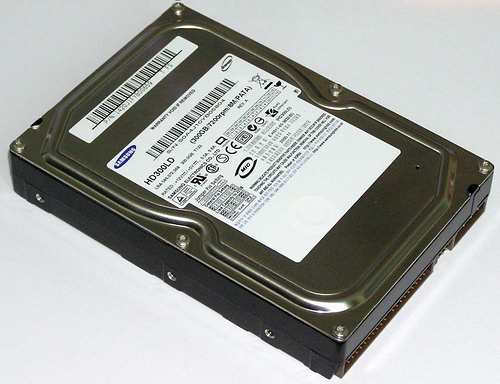 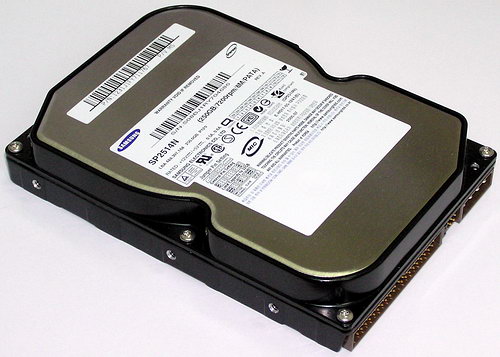 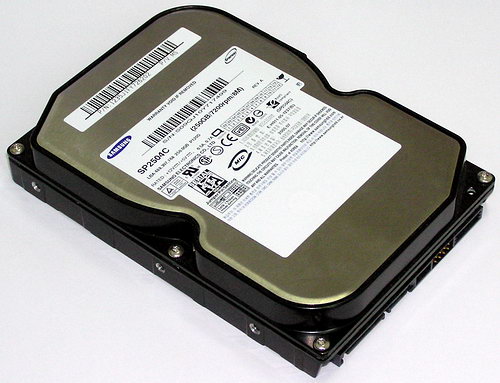 Samsung HD300LD (T133 series, top) as well as SP2504C and SP2514N models (SpinPoint P120 series, bottom). The differences are obvious.
The enclosure of new desktop hard disk drives from Samsung has become more classical, rectangular. There disappeared grooves at the top edges of the chamber as well as a plastic border and (unfortunately) four rubber feet at the back side of the enclosure, which used to cushion impacts during installation.  Traditional rubber feet at the base of 3.5-inch Samsung drives of the P120 and P80 series are no more in T133-series drives.
There are also some differences at the back side: for example, the chamber has become thicker in the center, stiffening ribs got a new profile, the logic board has also been slightly modified. 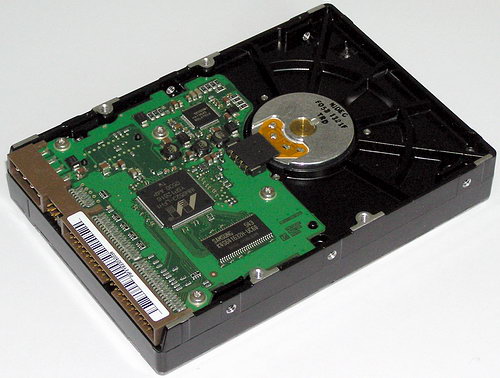 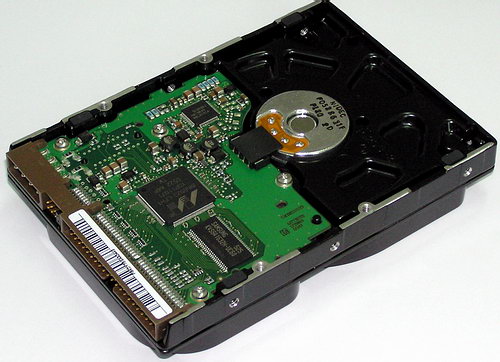  Samsung HD300LD (top) as well as SP2514N and SP2504C (bottom) models — a view from the controller board.
However, the controller board in Ultra ATA models (we currently have a T133-series drive with this interface only) resembles the board in P120-series drives, 
 
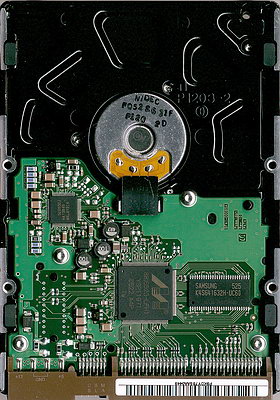 Samsung hard disk drives with Ultra ATA interface: HD300LD (top) and SP2514N (bottom).
it uses the same Marvell 88i6523 micro controller with parallel interface (we mentioned the innovative Marvell 88i6525 controller for Serial ATA II interface in connection with P120).  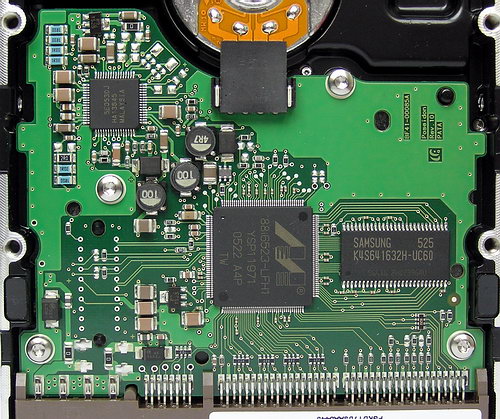 UltraATA controllers of Samsung HD300LD (top) and SP2514N (bottom) hard disk drives. The differences are minimal.
Unfortunately, Samsung engineers did not use the opportunity to reduce dimensions of the PCB, granted by a more compact SerialATA controller in these hard disk drives.  Samsung SP2504C SATA controller.
I repeat that innovations in the Marvell 88i6525 SATA-controller concern not only miniaturization (14x14 mm on the board) and full integration of nearly all necessary functional units on a die (so called SoC processor, System-On-Chip), as well as the great increase in a data read rate — up to 1.25 Gbit/s per channel (according to the specifications, even T133 provides no more than 1 Gbit/s per platter), but also power supply — power consumption of the chip is significantly reduced, though data can be transferred twice as fast (that is capacity of PHY buffers is noticeably higher than in Serial ATA 1.0 controllers). Basic specifications of Samsung hard disk drives of SpinPoint T133, P120 and P80 series are published in Table 1 (we simplified the P80-series nomenclature here). Table 1. Samsung SpinPoint T133, P120, and P80 Specifications.
Along with the increased capacity and data density we already mentioned, the new Samsung T133 drives differ from their P120-series predecessors by a somewhat increased disk transfer rate as well as slightly increased noise (by 1-2 dBA) and lesser non-operating shock resistance. Besides, the drives now consume a tad more power during operations and the spin-up power consumption also got higher — up to 800 mA and 2250 mA at +5 V and +12 V buses correspondingly versus 650 mA and 1900 mA for the P120). That's an inevitable cost of more platters. It's not clear why not use the faster UltraATA/133 interface (unlike the old series, the new one supports only UltraATA/100, ATA6). Especially as it uses the same controller. However, that's not much of a problem. According to the specifications, buffer size, average seek time, operating shock resistance, and reliability are on the same level as in the P120. Will Samsung expand the range of T133-series models towards smaller capacities, especially in the light of upgrading to denser data formats and TMR, we can only make guesses. And in conclusion we'll list those key features and technologies of the new hard disk drives, highlighted by the manufacturer:
Not long ago Samsung also changed the designation system for its HDD models. Now digits designate only capacity in gigabytes, two letters before the digits denote a class (H — hard disk drive, M or D — mobile or desktop). A letter after the digits stands for a number and type of heads (L=6, J=4, I=3, H=2). The last letter denotes a series and an interface. 
Test participantsIn this article we'll examine the following models: HD300LD SpinPoint T133 300 GB UltraATA/100 (manufactured in November 2005) and two senior SpinPoint P120 series models — 250 GB drives with UltraATA/133 and SerialATA interfaces (SP2514N and SP2504C correspondingly, Rev. A, manufactured in July 2005). We'll also publish the results of previously reviewed junior Samsung 200 GB P120-series models (SP2014N and SP2004C) as well as two senior P80-series models — SP1614N and SP1614C with UltraATA/133 and SerialATA 1.0 interfaces. The other manufacturers are represented by the following modern hard disk drives of similar capacity and configuration:
Results of all Samsung drives are grouped (in the same order) on top of diagrams, while the results of their competitors are published in the bottom part of the diagrams in order to avoid confusion and facilitate analysis.
Methods of testing performanceWe used the following testbed configuration to test hard disks:
The hard disks were firmly fixed on the metal rack of the PC case and connected to UltraATA/100 and SerialATA 1.0 controllers on the ICH5 bridge of the motherboard. The main hard disk was installed as master on the first channel of the chipset controller, and a hard disk to be tested was installed as master on the second channel of the same controller. In order to evaluate Serial ATA II and NCQ effect on performance, we also used Silicon Image SiI3124-2 controller (on the PCI32/33 bus, because results of the majority of tests on PCI-X bus for this controller with a single drive are practically the same. Besides, Samsung P120 drives themselves are evidently not intended for systems with PCI-X bus :). That's why their usage in our tests of a standard desktop configuration is well justified). A hard disk drive to be tested was firmly mounted on a metal rack of a PC case (without rubber pads). No additional cooling (special coolers and fans) was provided for the hard disks. Before the tests, we warmed the hard disks for 20 minutes using a utility with active random access. All the hard disks tested in this review had no problems with overheating and deterioration of characteristics at least during the six days of intensive testing. The tests were carried out under MS Windows XP Professional SP1. The hard disks were tested not partitioned (in Intel Iometer, H2Benchw and AIDA32 tests) as well as partitioned and formatted by regular operating system tools depending on a test type: one NTFS partition of maximum size for testing the average access time and plotting the read speed graph in WinBench 99 and two NTFS or FAT32 partitions of the same size for other tests (WinBench Disk WinMark 99, copying files with various patterns, ATTO Disk Benchmark test, multithreaded read/write Nbench 2.4 test and the hard disk speed test in Adobe Photoshop). Each NTFS partition occupied half of the entire disk capacity (that is the second partition started exactly from the second half of the disk). FAT32 partitions were 32768MB, the first one starting at the outer edge of the media (on the "fastest" tracks), and the second — exactly from the middle of the media volume. NTFS and FAT32 cluster sizes were selected by default — 4 and 16 KB correspondingly. We used AIDA32, H2benchw, and WinBench 99 tests to find out physical characteristics of drives (average access time, interface transfer rates, and linear disk transfer rates). To estimate the overall performance we use multiple patterns from Intel Iometer, a good test C'T H2Benchw, Adobe Photoshop swapping performance, multithreaded read/write, and the generally recognized WinBench 99 (though we don't pay much attention to the latter in our conclusions, because we have often found out about drive and controller optimizations for this test).
Results of the physical parameter testsFirst of all, we are going to publish linear reading graphs (click on them to see full-size pictures).
The latest Samsung drives demonstrate an unusual picture: no traditional flat steps with a constant rate, no sweeping periodic oscillations as in SpinPoint P80 (though the zone structure is distinct in all cases). SpinPoint P80 drives on 80 GB platters were the first Samsung storage drives to use elastic bits per inch technology (AKA adaptive formatting from IBM :)), when each side of a platter was formatted with individually adjusted track density, in order to fully reveal the performance potential of the existing magnetic recording technology without losing reliability (a head with better characteristics records data with higher density and vice versa, which allows to keep BER (Bit error rate) and the average data density (to some degree) at a specified level, that is elastic BPI contributes to better quality and faster performance). So, SpinPoint P120 and T133 drives also use EBPI technology. But Samsung evidently changed its approach to this technology as well as to the address translator (physical into logical). It now resembles Hitachi's modern method (the graph for Hitachi Deskstar T7K250 with adaptive formatting is published above), where the period of platter interleaving within formatting zones has become noticeably smaller, that is you will not see it on a rectified graph, it's partially smoothed over by the address translator. At the same time, the zone steps lost their flatness due to the elastic data density (unlike Maxtor drives, where adaptive formatting has almost no effect on flatness of linear read/write rate graphs, obtained by traditional methods and utilities). What concerns linear disk transfer rates, both samples of P120-series 250 GB drives demonstrated excellent results within 75 million bytes per second at maximum, having outperformed the majority of modern desktop ATA drives. The SP2514N and SP2504C models also lead in average and minimum rates, significantly outperforming not only the majority of their competitors, but also SP2014N and SP2004C models of the same series, which use 100GB formatting of platters. Thus, true 125 GB platters allow Samsung hard disk drives to demonstrate excellent linear access performance — even better than in Seagate drives with 133 GB platters or in Maxtor and WD drives with 125 GB platters! What concerns our T133-series HD300LD under review, the first-born expectedly uses old GMR heads and 100 GB platter formatting. That's why its performance is close to 200GB P120-series models and the majority of P80-series drives: about 60 million bytes per second at maximum will not break any records today. ;) In this case (HD300LD), Samsung engineers actually stepped on the same rake as when they designed SP2014N and SP2004C (they slightly modified 80GB platters by making tracks narrower and leaving data density along the tracks almost on the same level). So we can only wait for the 400 GB T133 model to enjoy new linear transfer rates in full measure. However, it would be naive to think that everything depends on linear transfer rates only. Other HDD performance characteristics are sometimes more important in typical user applications. Let's proceed to their analysis. Samsung drives traditionally cannot compete with the leaders in UltraATA and Serial ATA transfer rates. But I wouldn't take it for a disadvantage, as 8 MB buffer makes small performance differences not that critical. Another thing is of higher importance here — linear disk transfer rates (read/write) of desktop drives have come close to 80 million bytes per second (for example, for Seagate Barracuda 7200.9 with 160 GB platters), while the effective UltraATA/100 transfer rate for many controllers is about 80 MB/s. This situation is similar to what we saw with UltraATA/33, when the interface bandwidth was insufficient for HDD needs and UltraATA/66 interface had to be introduced to the market that was not yet ready for it. Fortunately, the market has been prepared beforehand now, UltraATA/133 and SerialATA/150 have already existed for a long time, but the traditional UltraATA/100 will soon become insufficient. That's why manufacturing hard disk drives with this interface is not quite correct now, as it will limit maximum HDD performance. In this connection, it's very strange to give up UltraATA/133 in favour of UltraATA/100 in SpinPoint T133 series drives. However, we'll wait for the 400 GB model and check it up one more time. ;) The existing interfaces seem to be sufficient so far. Samsung HD300LD of the T133 series is practically on a par with P120-series drives with fewer platters. That's good news. But P80-series drives were faster in seek mode. These Samsung drives certainly support seek acoustics control. Access time in quiet seek mode (AAM register contains 0dec or 128-253dec) grows generally by nearly 2 ms. Seek noise becomes duller (nearly inaudible against the rotational noise), though Samsung desktop drives are not that noisy (especially high-frequency components) even without it (that is in regular seek mode). We can try to judge about the efficiency of lazy write firmware procedures and caching data for writing by the drop of the average write access time, measured by the operating system, relative to the read access time with enabled write-back caching. We use C'T H2benchW results for this purpose. While everything looks quite progressive for the row SP16x4x—SP20x4x—SP25x4x (caching random write data gets better), the results of the HD300LD are not inspiriting — this hard disk drive is outperformed in this parameter not only by its predecessors, but also by most competitors. Having compared the results of hard disk drives of the same P120 series of different capacities, we can draw a conclusion that the average access time for writing in this test is influenced much by the linear disk access rate, which is noticeably higher in the SP25x4x, as their caching algorithms must be the same in this section. Another illustrative test of the "interior design" and the firmware efficiency of the hard disks is the read/write speed on files of various sizes with various block sizes — from 512 bytes to 1 MB. For this purpose we use ATTO Disk Benchmark. The screenshots below display the results for the four sizes of a test file — 128KB, 1MB, 4MB, and 32MB. While the first and the second file sizes are, as a rule, surely cached in the disk buffer (caching read/write data for a 1 MB file is not that simple), there is simply no room to fit in the last file size. Caching the last but one file size depends not only on the buffer size, but also on the hard disk firmware (by the way, results of this test practically don't depend on the choice between FAT and NTFS).
ATTO Disk Benchmark 2.02 results for three generations of Samsung hard disk drives.
That's an evident improvement in caching algorithms in the latest-gen drives compared to the old P80 — faster writing with the smallest blocks as well as cardinally improved anticipatory reading of large data volumes (you can see it with 1-4 MB test files)! But on the other hand, the rate of reading larger files (8-32 MB) at small blocks (2-16 KB) has dropped a little. There are no significant differences between T133- and P120-series drives here — they actually use the same micro controller. That's why the SP2514N is victorious only with the largest files, which just don't fit into cache. It's thanks to the best linear access rate only. Now let's proceed to testing performance in applications.
Performance in applicationsFirst of all, let's see how these drives are optimized for multi-threaded operations. I traditionally use NBench 2.4 tests for this purpose, where 100MB files are written to disk and then read from it in several simultaneous threads — both closely and distantly located on the drive (in this case we used FAT32). The diagram below shows only average read/write performance in several patterns, you can see the details (without comments) on a separate web page. Multi-threaded write performance demonstrates several interesting issues. First of all, all the three models under review look excellent here, having taken the leading positions. We can draw a conclusion that lazy write (and stream write caching) algorithms in modern Samsung drives are implemented on a very high level, only few competitors (like Maxtor) can compete with them in this respect. Secondly, the leaders among Samsung drives have higher linear rates. That's understandable. Thirdly, the ultimate leader here is the SP2504C model with Serial ATA interface. Do you know why? As a rule, identical models with different interfaces (PATA or SATA without NCQ) demonstrate similar performance in the majority of tests. The answer is yes, that's usually so. But not in this case! Scroll up a little to reread the comment on the interface transfer rate test! The pair of Samsung SP25x4x drives provide us with one of the first practical proofs of our conclusions about a coming end of the UltraATA/100 interface: in case of effective algorithms of caching write data and the interface transfer rates close to the linear disk transfer rates, the current interface transfer rate becomes insufficient for effective caching; only a faster interface can allow lazy write algorithms to reveal their full potential. That's the case with the SP2404C. And it has nothing to do with the SP2514N. Another proof of this fact is the difference between regular and quiet seek modes: while in case of the SP2504C the quiet seek mode for writing is as fast as the regular seek mode, the HD300LD with a slower interface demonstrates a noticeable difference between the seek modes in this test. What concerns multithreaded reading, senior P120-series models also fair well (prize-winners), though they are way to go to the magnificent Maxtor. Effect of the interface transfer rate is practically imperceptible in this case. The Sp2504C with the SiI3124 controller demonstrates an unexpected trough, even though NCQ must have improved results in this test (as is the case with the other NCQ-drives with the same controller). In this case the situation with the SP2004C repeats itself. To all appearances, NCQ causes some problems in Samsung drives of this generation (not only in Samsung drives, though). Now let's have a look how the hard drives fair in old but still popular Disk WinMark 99 tests from the WinBench 99 package. We carry out these tests not only for the beginning but also for the middle part (in terms of capacity) of physical hard drives for two file systems. The diagrams display average results. Setting aside phenomenally high results in this test with the SiI3124 controller, the business test favours Hitachi and Maxtor drives, but the 250 GB Samsung models also demonstrate good results. On the contrary, the HD300LD is outperformed even by the SP20x4x. High-End test makes the leadership of Maxtor and SP25x4x drives more pronounced, but the HD300LD looks a tad better than its predecessor with 100 GB platters. And now it's time for complex performance tests in PCMark04 and C'T H2BenchW benchmarks. They both play back prerecorded hard disk activity scenarios in corresponding applications and measure the completion speed of each scenario. After that the results are averaged. Hitachi is a traditional leader in Futuremark PCMark04 HDD test, but 250 GB Samsung models with 125 GB platters have come close to the leader, having outperformed the other drives. It proves that their success in other tests is not accidental. 100GB-platter Samsung drives are very unassuming here. A similar test C'T H2benchW is more sensitive to differences between the models, but the situation is the same here — Hitachi T7K250 and Samsung SP25x4C/N are the leaders. Though we see no gains from using NCQ in the SP2504C model. Maxtor and Hitachi drives again take the lead in Adobe Photoshop swapping performance, though the 125GB-platter model from Samsung fairs very well, unlike the HD300LD, SP20x4, and SP1614N. Again no NCQ effect for the Samsung drive.
Intel Iometer testsWe also use special patterns in Intel IOmeter to imitate hard disks operating in various applications. At first — traditional well-spread patterns, offered by Intel and Storagereview.com — DataBase, File Server, Web Server, and Workstation. As you will hardly want to use Samsung drives in serious servers, we are going to publish only mean data for three server patterns and four queue depths (1, 4, 16, and 64). The data was averaged geometrically without weight coefficients. Full results of each pattern are published without comments on a separate web page. The best results are demonstrated by the SP2504C model here, connected to the SiI3124 controller. NCQ seems to play a positive role in this case. Connected to ICH5, this hard disk drive demonstrates similar performance as the SP2514N and some other drives, including P120-series 200 GB models. Results of the HD300LD in this test are not high. We can only console ourselves with the thought that these storage drives are not intended for such tasks. Approximately the same picture can be seen in the workstation pattern (which is actually not so different from the above server patterns). All P120 and P80 drives are approximately on a par here; the T133 series (represented by the HD300LD) lags behind. Now it's turn for our IOmeter patterns, which are closer to users of regular desktop PCs (detailed results are on a separate web page). In the imitation of reading and writing large files (like mp3, video, large photos, etc) 250GB Samsung models shoot forward, outperforming even the traditional leader from Maxtor. The HD300LD, on the contrary, is outperformed by all its P120-series counterparts, though it's faster than the P80 and those drives from Seagate and WD. Hitachi, Maxtor, and Samsung P80 drives turn out better at random reading of large files, while all P120- and T133-series models are approximately on a par, being a tad slower than their competitors. The situation with copying small files is similar to that for large files: Hitachi and Maxtor are a tad faster in writing, though Samsung P120 250 GB drives are only a fraction behind. But the file copy pattern demonstrates a fantastic break-through: SpinPoint P120 drives are superior to ALL their competitors, even the traditional leaders. P120-series 250 GB drives look the best here (especially the SATA modification with the SiI3124 controller). Samsung has been optimizing firmware to increase file copy performance for a long time already, but this example just leaves no chances to competitors. However, competitors still have chances in random copying of small files, they are not outperformed that much here. Unfortunately, the new HD300LD model is nothing special here either — all laurels are won by the P120 series based on 125 GB platters. According to the geomean of the six previous patterns (reading, writing, and copying files at random addresses), Samsung P120-series drives are well ahead of the others. Models on 125 GB platters are noticeably faster at that. What concerns the new model in the T133 series on 100 GB platters, it's slower even compared to its two-platter counterpart from the P120 series (that is SP2014N), though it's faster than most models from the other manufacturers). Seagate programmers seem to be too clever by half, trying to improve operations with cache data. The best is the enemy of the good, they say. They should have left the firmware unchanged, as far as such algorithms are concerned. SiI3124 NCQ controller in the SP2504C model yields almost no gain in this case — the average gain is about 2%, it can hardly be considered as a noticeable bonus. The problem is not in NCQ, I guess, but in Silicon Image caching drivers. We'll leave defragmentation patterns without comments, as the situation there resembles the previous diagram. But the situation in the streaming read/write pattern with large and small blocks (for example, typical PC operations for editing digital video or in timeshifting mode) is of two kinds. On one hand, Maxtor, Seagate, and WD drives are faster at typical large blocks, while all Samsung drives are approximately on the same level as well as the Hitachi T7K250. But on the other hand, Samsung drives of the latest series (P120 and T133) shoot forward at small 4KB blocks, leaving no chances to their competitors. The secret of outstanding results in copying files and in some other applications probably lies in firmware optimizations for simultaneous reading and writing of small blocks.
Acoustic noise and power consumptionAs we have already discussed, an increased number of platters (3) inevitable leads to the noise growth in T133, though the HD300LD model is still very quiet — nearly as quiet as P120-series models. Subjectively, all these Samsung drives generate distinct low-frequency rotational noise (unlike many competitors), while there is very little high-frequency noise, both rotational and in active seek mode. What concerns the power consumption and heat dissipation, you can look them up in the table with specifications at the beginning of the article. They are really not bad: P120 consumes less power than P80; but power dissipation of T133 has grown approximately to the level of P80.
ConclusionWell, Samsung evidently devoted more energies to create new HDD models for desktop computers last year. Having launched the P120 series in the beginning of 2005 and then having upgraded it to 125 GB platters (in senior 250 GB models), the company updated the model range of the P80 series (models with new interface, firmware, etc). At the end of the year, it started manufacturing 300 GB models - the company promised to catch up with its competitors in maximum capacity in the beginning of 2006 by launching 400 GB models of the new T133 series with TMR heads. Thus, the Korean company nearly caught up with its competitors by the end of the year, while a year ago Samsung had been evidently lagging behind in terms of maximum capacity of desktop drives (the company met Year 2005 without a 200 GB model and 100 GB platters). We can also note that 250GB models with 125GB platters are an evident success, as they demonstrated very good performance in a number of typical desktop applications. They combined improved reliability, good shock resistance, little noise and low operating temperatures. At the same time, the first tests of the T133-series 300GB model with three platters, to which the company returned after many years of using maximum two platters in their hard disk drives, demonstrated a number of bottlenecks (even compared to P120-series drives). Let's hope that engineers will fix them in a creative and quick way. We look forward to T133-series 400GB models, which will be able to demonstrate the highest linear access rate (up to 80 MB/s), a fast interface, more efficient NCQ and traditional caching. But let's not guess at the future...
Write a comment below. No registration needed!
|
Platform · Video · Multimedia · Mobile · Other || About us & Privacy policy · Twitter · Facebook Copyright © Byrds Research & Publishing, Ltd., 1997–2011. All rights reserved. | ||||||||||||||||||||||||||||||||||||||||||||||||||||||||||||||||||||||||||||||||||||||||||||||||||||||||||||||||||||||||||||||||||||||||||||||||||||||||||||||||||||||||||||||||||||||||||